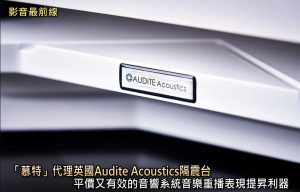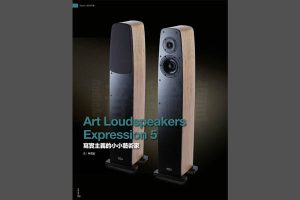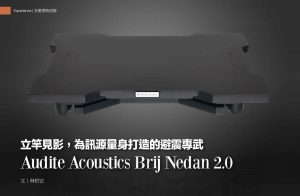Hardware Reviews
Art Emotion Carbon 6: fast, compelling, well balanced

Art Emotion Carbon 6 loudspeakers
The latest range of loudspeakers from Art may only have been in production for a matter of months, but they owe their existence to an ongoing quest by the company to refine its innovative cabinet designs and choice of drive units. This has resulted in the current comprehensive line-up of models, starting with the Expression 6M bookshelf at £5,750 and topped off by the Impression Diamond Reference 15 at £54,950.
At £10,500, the Emotion Carbon 6 floorstander sits in the middle of the Emotion Carbon series with its six inch SEAS Nextel-coated paper bass/mid driver and 25mm carbon dome SEAS tweeter. The range also has a smaller two-way floorstander with a five inch driver, a bookshelf model, and two bigger three-ways, one with five inch mid and eight inch woofer, and the other with eight inch mid and 10 inch woofer.
I first saw the new Art speakers at the London Audio show at Heathrow this year and was fascinated by the way the cabinet is put together. After a quick listen, albeit under show conditions, and an interesting chat with the company’s co-founder Derek Dunlop, I put in a request for a pair to review.

If the Dunlop name sounds familiar, that’s because the family has a long history in the world of hi-fi. Derek’s late father Peter ran a precision engineering company called Dunlop Westayr, which bought suspended subchassis turntable manufacturer Ariston in 1973 from founder Hamish Robertson. Dunlop Westayr/Ariston closed in 1977 and in 1978 Peter, Derek and his brother Ramsay set up Systemdek to manufacture turntables. In 1998, Systemdek sold the rights to manufacture its award-winning IIX turntable to Audio Note UK and it is still made to this day.
Derek then started Art with Ramsay, to manufacture speakers. They continued to make some of the Systemdek turntables for a short while, but they soon deferred to making loudspeakers only, although Derek, with a twinkle in his eye, did say that this may change in the near future, so watch this space. So Art has a long history in making loudspeakers and Derek tells me they have continued to refine their cabinet designs over the past 15-plus years.
The Deco model in 2007/8 was their first foray into a laminated or layered cabinet design. These used a series of 36mm MDF slices glued together, running front-to-back, and cut out in the middle to form an internal cavity. In 2012 came the original Alnico range, and that again used slices of MDF, but this time layered in a top-to-bottom configuration, with a metal baffle for the drive units.
The current speaker line-up, including the Emotion Carbon 6, owes its cabinet design concept to the Deco, but instead of MDF, Art now use birch plywood layers (10 x 24mm slices front to back with a 50-65mm cabinet wall thickness), the baffles that bolt on front and back are made from a material from the USA called Richlite, which is made from paper and phenolic resin.

Art are also benefiting from CNC machinery that allows them not only to cut out the middle of each sheet to form the internal cavity, but also give the internal surfaces of the cabinet a wavy finish rather than the usual flat sheet, which, Derek tells me, minimises standing waves, unwanted resonances and distortions by diffusing the internally reflected sound waves.
By shaping each ‘slice’, Art are also able to make integral internal braces and even form the reflex port using this method rather than using the usual glued in plastic pipe. As Derek says, this design of reflex port also acts as an additional internal cabinet brace to increase rigidity. And all of this attention to detail, he adds, means “you end up with an amazingly strong cabinet that is very inert and delivers a much clearer sound”. The cabinets are made entirely in-house by Art.
Derek also tells me that the carbon dome SEAS tweeter in the Emotion Carbon 6 is a brand-new addition to the Norwegian company’s portfolio. He says they chose the carbon unit for its “clean, yet unfatiguing presentation – making it ideal for the crucial high frequencies thanks to its piston-like motion”.
The choice of a coated paper-coned bass/mid driver, says Derek, is because he has found that material “is the most natural-sounding”. He adds: “Without going into the list of so-called miraculous materials that are out there, let me just say that we stick with treated paper” as they don’t want to impose any kind of “character” to the sound.

The crossover itself uses third-order networks with air-cored inductors that they make in-house and Clarity polypropylene capacitors from Wales. All internal wiring is heavy-gauge, multi-stranded copper. He tells me the speakers are an easy load and, as a fan of valve amps himself, he assured me that my Audio Note Meishu Tonmeister (single-ended 300B with around 10W of power) should drive them no problem at all.
The Art of music
For my listening I put the Emotion Carbon 6s on the end of that amp, with an Audio Note TT3/Arm Two/Io 1/S9 vinyl front end and that company’s CDT Five CD transport and DAC5 Special. Art recommends placing the speakers around 600mm from a rear wall, although they say that can be reduced to 150mm in smaller rooms. I did the dance with them, starting out at around 300mm from my rear wall and moving them closer and further away, but in the end had to agree that they worked best at 600mm and slightly toed-in. I started by not using the spikes provided, but felt there was a slight improvement to the sound with them fitted.
It took only a few seconds of George Benson’s No One Emotion from his 20/20 album for me to know that I was going to like the Emotion Carbon 6. The sound was fast, clean, detailed, well layered and the synth bass line that pumps the track along at breakneck speed was tight, deep and agile. Benson’s vocals were open and articulate and drums and percussion were detailed and delicate. My acid test on that track is that scorching guitar solo from Michael Sembello, and the Carbon 6 had just the right balance of raunchiness and detail, without being forward or aggressive.
By stark contrast, I moved from the lush, luxuriously layered arrangement of the Benson track to Red Lights in the Rain from Canadian singer/songwriter/guitarist Stephen Fearing from his album with Rega. This simple track, just Fearing and his custom Manzer Cowpoke acoustic, leaves a speaker nowhere to hide. The Carbon 6 showed itself to be more than up to the challenge. Fearing’s vocals were open and dripping with emotion and subtle nuances, while his guitar was clean, clear and articulate. This recording beautifully captures the body resonances and lower registers of his guitar, and this was nicely conveyed by the Carbon 6, which also let you hear how each note was played and how his fingers moved on the strings.

Stepping away from guitarists, I decided to see what the Carbon 6 could do with saxophone, and played The Bright Side from Dave Koz’s brilliant The Dance CD. His alto sax was nicely voiced and articulated by the Carbon 6, which gave excellent insights into his technique and how he shaped and pushed each note. Percussion was well defined and crisp, full of detail and syncopation, while keyboards were clearly delineated. I let the CD play on to the next track, Don’t Give Up, and was very impressed with the clarity and detail on Burt Bacharach’s piano. Koz played soprano sax for this track and the Carbon 6 clearly voiced the differences between the two instruments.
I couldn’t resist spinning up Luther Vandross’s Give Me the Reason LP for a quick blast of my favourite track, So Amazing. Again the Carbon 6 took it in its stride, with great emotion and power in his vocals and a good weight and impetus to Marcus Miller’s bass line. The various layers of this lavish production were cleanly presented by the Carbon 6, which kept everything separate, while preserving the interplay of the various instruments.
Verdict
I played many more tracks than I have space to mention here. But the Art Emotion Carbon 6 brought the same qualities to them all. They were fast, adept at keeping a track’s tempo intact and your foot tapping along, while revealing the subtleties and nuances in the various layers of the music and the contributions of individual musicians. They never shouted, never added any annoying colourations, were always fast, compelling, well balanced with an excellent soundstage. They also worked beautifully with the Meishu amp, proving that a good, low-powered valve amp should be a good match.
The more I listened to the Emotion Carbon 6, the more I liked them. They are beautifully made, well engineered and handled everything I threw at them. If you have around £10,000 to spend on a floorstanding speaker, I highly recommend the Art Emotion Carbon 6, it would be a mistake to leave them off your shortlist.
Crossover frequency: 2.9kHz
Drive units:
Mid/bass: SEAS 180mm Nextel-coated paper cone
Tweeter: SEAS 25mm carbon dome
Nominal frequency response: +/ -3dB 32 – 30,000 Hz
Nominal impedance: 8 Ohms
Connectors: WBT Platinum binding posts
Sensitivity: 87.5dB @ 2.83v/1m
Cabinet: machined birch ply and cellulose phenolic resin panels
Dimensions HxWxD: 1044 x 260 x 250mm
Weight: 33kg
Finishes: natural or choice of RAL colours
Warranty: 5 years
£10,500
T +44 (0) 1292 319416
E contact@loudspeaker-art.com
http://www.loudspeaker-art.com



